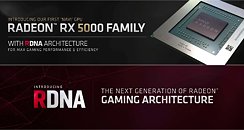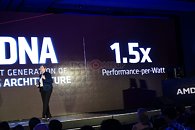Monday, June 3rd 2019

Rumor: AMD Navi a Stopgap, Hybrid Design of RDNA and GraphicsCoreNext
The Wheel of Rumors turns, and assumptions come and pass, sometimes leaving unfulfilled hopes and dreams. In this case, the rumor mill, in what seems like a push from sweclockers, places Navi not as a "built from the ground-up" architecture, but rather as a highly customized iteration of GCN - iterated in the parts that it actually implements AMD's RDNA architecture, to be exact. And this makes sense from a number of reasons - it's certainly not anything to cry wolf about.
For one, AMD's GCN has been a mainstay in the graphics computing world since it was first introduced back in 2012, succeeding the company's TeraScale architecture. Game engines and assorted software have been well optimized already to take advantage of AMD's design - even with its two ISAs and assorted improvements over the years. One of the most important arguments is derived from this optimization effort: AMD's custom designs for the console market employ architectures that are GCN-based, and thus, any new architecture that would be used by both Microsoft and Sony for their next-generation consoles would have to be strictly backwards compatible.Of course, with the Xbox One X, you can brute-force compatibility with previous-gen games via a software emulator (that sometimes presents better results than the originals). However, that wouldn't cut it for the next generation of consoles - the work needed to develop a software emulation that was able to render some of the current-gen games at their level of detail (think some of the 4K-rendered titles on Xbox One X, for example) would likely be an insurmountable task. Backwards compatibility at the hardware level would always be a prerequisite, and I bet you anything that AMD made sure to use Microsoft and Sony's funding to develop their RDNA design that they're partly employing with Navi - the GPU that will power the next generation of consoles.
This means that AMD's Navi keeps its GCN bloodline in a way that allows it to have - I'd wager - an almost completely automatic backwards compatibility with current-gen titles. However, the fact that Navi already employs AMD's RDNA means that developers will also need to learn to code for the new architecture - thus easing their way into it, rather than facing a completely different new GPU design at once. Everybody wins, really - Sony and Microsoft get to keep their backwards compatibility; AMD uses their funding to develop their custom hardware, including part of the RDNA architecture; and developers get to keep compatibility with AMD's design, whilst having new architectural toys to play with.Another argument is that AMD could be looking to completely separate their graphics and compute architectures - they do say that RDNA was developed with gaming workloads in mind, which means that they won't be making the same strides they've been in the past years when it comes to compute workloads. And we all know that's where the real money lies - should AMD be able to break into that market with enough force, of course.
Speculation, certainly. But it seems we may have to wait until 2020 to see AMD's RDNA architecture in its full-glory implementation - and it'll come to PC first. Until then, nothing is stopping the hybrid Navi from being exactly what gaming ordered.
Source:
Sweclockers
For one, AMD's GCN has been a mainstay in the graphics computing world since it was first introduced back in 2012, succeeding the company's TeraScale architecture. Game engines and assorted software have been well optimized already to take advantage of AMD's design - even with its two ISAs and assorted improvements over the years. One of the most important arguments is derived from this optimization effort: AMD's custom designs for the console market employ architectures that are GCN-based, and thus, any new architecture that would be used by both Microsoft and Sony for their next-generation consoles would have to be strictly backwards compatible.Of course, with the Xbox One X, you can brute-force compatibility with previous-gen games via a software emulator (that sometimes presents better results than the originals). However, that wouldn't cut it for the next generation of consoles - the work needed to develop a software emulation that was able to render some of the current-gen games at their level of detail (think some of the 4K-rendered titles on Xbox One X, for example) would likely be an insurmountable task. Backwards compatibility at the hardware level would always be a prerequisite, and I bet you anything that AMD made sure to use Microsoft and Sony's funding to develop their RDNA design that they're partly employing with Navi - the GPU that will power the next generation of consoles.
This means that AMD's Navi keeps its GCN bloodline in a way that allows it to have - I'd wager - an almost completely automatic backwards compatibility with current-gen titles. However, the fact that Navi already employs AMD's RDNA means that developers will also need to learn to code for the new architecture - thus easing their way into it, rather than facing a completely different new GPU design at once. Everybody wins, really - Sony and Microsoft get to keep their backwards compatibility; AMD uses their funding to develop their custom hardware, including part of the RDNA architecture; and developers get to keep compatibility with AMD's design, whilst having new architectural toys to play with.Another argument is that AMD could be looking to completely separate their graphics and compute architectures - they do say that RDNA was developed with gaming workloads in mind, which means that they won't be making the same strides they've been in the past years when it comes to compute workloads. And we all know that's where the real money lies - should AMD be able to break into that market with enough force, of course.
Speculation, certainly. But it seems we may have to wait until 2020 to see AMD's RDNA architecture in its full-glory implementation - and it'll come to PC first. Until then, nothing is stopping the hybrid Navi from being exactly what gaming ordered.





30 Comments on Rumor: AMD Navi a Stopgap, Hybrid Design of RDNA and GraphicsCoreNext
When Nvidia snuck-in TBR with Maxwell it was a bad day for AMD. I don't know who miss that in 2014 (Raja), or why it didn't get it into Ellesmere/Polaris (GCN 4.0) July 2016, or sure who didn't spend time constructing the drivers. As by Aug 2017 Vega they should have found a team that could implement that. You maybe correct in "Achilles heel", or they didn't have the resources (people/money) to spend given the chip were still compute heavy (Professional focused) and might still not provide the utmost efficiency (And they'd still look bad).
It would be interesting if AMD/RTG can get Tiled rendering in Navi.
Anyway, the days of being cash strapped should be coming to an end for AMD, I was really hoping they'd be done with stopgap solutions.